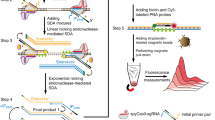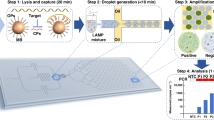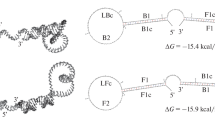Abstract
Infectious diseases remain one of the major causes of death worldwide in developing countries. While screening via conventional polymerase chain reaction (PCR) is the gold standard in laboratory testing, its limited applications at the point-of-care have prompted the development of more portable nucleic acid detection systems. These include isothermal DNA amplification techniques, which are less equipment-intensive than PCR. Unfortunately, these techniques still require extensive sample preparation, limiting user accessibility. In this study, we introduce a novel system that combines thermophilic helicase-dependent amplification (tHDA) with a Triton X-100 micellar aqueous two-phase system (ATPS) to achieve cell lysis, lysate processing, and enhanced nucleic acid amplification in a simple, one-step process. The combined one-pot system was able to amplify and detect a target gene from whole-cell samples containing as low as 102 cfu/mL, and is the first known application of ATPSs to isothermal DNA amplification. This system’s ease-of-use and sensitivity underlie its potential as a point-of-care diagnostic platform to detect for infectious diseases.

ᅟ





Similar content being viewed by others
References
WHO. WHO | Infectious diseases. WHO; 2016.
Yager P, Domingo GJ, Gerdes J. Point-of-care diagnostics for global health. Annu Rev Biomed Eng. 2008;10:107–44. https://doi.org/10.1146/annurev.bioeng.10.061807.160524.
Fonkwo PN. Pricing infectious disease. The economic and health implications of infectious diseases. EMBO Rep. 2008;9(Suppl 1):S13–7. https://doi.org/10.1038/embor.2008.110.
Burns MA, Johnson BN, Brahmasandra SN, Handique K, Webster JR, Krishnan M, et al. An integrated nanoliter DNA analysis device. Science. 1998;282:484–7.
Song J, Mauk MG, Hackett BA, Cherry S, Bau HH, Liu C. Instrument-free point-of-care molecular detection of Zika virus. Anal Chem. 2016;88:7289–94. https://doi.org/10.1021/acs.analchem.6b01632.
Van Dorst B, Cremers A, Jans K, Van Domburg T, Steegen K, Huang C, et al. Integration of clinical point-of-care requirements in a DNA microarray genotyping test. Biosens Bioelectron. 2014;61:605–11. https://doi.org/10.1016/j.bios.2014.05.071.
Holland C, Kiechle F. Point-of-care molecular diagnostic systems—past, present and future. Curr Opin Microbiol. 2005;8:504–9. https://doi.org/10.1016/j.mib.2005.08.001.
Fakruddin M, Mannan KS, Chowdhury A, Mazumdar RM, Hossain MN, Islam S, et al. Nucleic acid amplification: alternative methods of polymerase chain reaction. J Pharm Bioallied Sci. 2013;5:245–52. https://doi.org/10.4103/0975-7406.120066.
Cao Y, Kim H-J, Li Y, Kong H, Lemieux B, Cao Y, et al. Helicase-dependent amplification of nucleic acids. In: Current protocols in molecular biology. Hoboken: Wiley; 2013. p. 15.11.1–15.11.12.
Chow WHA, McCloskey C, Tong Y, Hu L, You Q, Kelly CP, et al. Application of isothermal helicase-dependent amplification with a disposable detection device in a simple sensitive stool test for toxigenic Clostridium difficile. J Mol Diagn. 2008;10:452–8. https://doi.org/10.2353/jmoldx.2008.080008.
Torres-Chavolla E, Alocilja E. Nanoparticle based DNA biosensor for tuberculosis detection using thermophilic helicase-dependent isothermal amplification. Biosens Bioelectron. 2011;26:4614–8. https://doi.org/10.1016/j.bios.2011.04.055.
Albertsson PA. Partition of cell particles and macromolecules: separation and purification of biomolecules, cell organelles, membranes, and cells in aqueous polymer two-phase systems and their use in biochemical analysis and biotechnology. Wiley; 1986.
Schütte H Protein purification by aqueous two-phase systems. In: Protein structure analysis. Springer Berlin Heidelberg, Berlin, Heidelberg; 1997. p. 31–48.
Fisher D. The separation of cells and organelles by partitioning in two-polymer aqueous phases. Biochem J. 1981;196:1–10. https://doi.org/10.1042/bj1960001.
Mashayekhi F, Meyer AS, Shiigi SA, Nguyen V, Kamei DT. Concentration of mammalian genomic DNA using two-phase aqueous micellar systems. Biotechnol Bioeng. 2009;102:1613–23. https://doi.org/10.1002/bit.22188.
Nikas YJ, Liu CL, Srivastava T, Abbott NL, Blankschtein D. Protein partitioning in two-phase aqueous nonionic micellar solutions. Macromolecules. 1992;25:4797–806. https://doi.org/10.1021/ma00044a048.
Quina FH, Hinze WL (1999) Surfactant-mediated cloud point extractions: an environmentally benign alternative separation approach. https://doi.org/10.1021/ie980389n
Kamei DT, King JA, Wang DIC, Blankschtein D. Separating lysozyme from bacteriophage P22 in two-phase aqueous micellar systems. Biotechnol Bioeng. 2002;80:233–6. https://doi.org/10.1002/bit.10377.
Ribeiro SC, Monteiro GA, Cabral JMS, Prazeres DMF. Isolation of plasmid DNA from cell lysates by aqueous two-phase systems. Biotechnol Bioeng. 2002;78:376–84. https://doi.org/10.1002/bit.10227.
Mashayekhi F, Chiu RYT, Le AM, Chao FC, Wu BM, Kamei DT. Enhancing the lateral-flow immunoassay for viral detection using an aqueous two-phase micellar system. Anal Bioanal Chem. 2010;398:2955–61. https://doi.org/10.1007/s00216-010-4213-7.
Mashayekhi F, Le AM, Nafisi PM, Wu BM, Kamei DT. Enhancing the lateral-flow immunoassay for detection of proteins using an aqueous two-phase micellar system. 2012 2057–2066. https://doi.org/10.1007/s00216-012-6278-y.
Jue E, Yamanishi CD, Chiu RYT, Wu BM, Kamei DT. Using an aqueous two-phase polymer-salt system to rapidly concentrate viruses for improving the detection limit of the lateral-flow immunoassay. Biotechnol Bioeng. 2014. https://doi.org/10.1002/bit.25316.
Chiu RYT, Thach AV, Wu CM, Wu BM, Kamei DT. An aqueous two-phase system for the concentration and extraction of proteins from the interface for detection using the lateral-flow immunoassay. PLoS One. 2015;10:e0142654. https://doi.org/10.1371/journal.pone.0142654.
Cheung SF, Yee MF, Le NK, Gomes EA, Afrasiabi Z, Kamei DT (2017) A combined aqueous two-phase system and spot-test platform for the rapid detection of Escherichia coli O157:H7 in milk. SLAS Technol Transl Life Sci Innov 247263031773189. https://doi.org/10.1177/2472630317731892.
Aránzazu Partearroyo M, Ostolaza H, Goñi FM, Barberá-Guillem E. Surfactant-induced cell toxicity and cell lysis. A study using B16 melanoma cells. Biochem Pharmacol. 1990;40:1323–8.
Linnes JC, Rodriguez NM, Liu L, Klapperich CM. Polyethersulfone improves isothermal nucleic acid amplification compared to current paper-based diagnostics. Biomed Microdevices. 2016;18:30. https://doi.org/10.1007/s10544-016-0057-z.
Du X, Zhou T, Li P, Wang S. A rapid Salmonella detection method involving thermophilic helicase-dependent amplification and a lateral flow assay. Mol Cell Probes. 2017;34:37–44. https://doi.org/10.1016/j.mcp.2017.05.004.
Mahalanabis M, Do J, ALMuayad H, Zhang JY, Klapperich CM. An integrated disposable device for DNA extraction and helicase dependent amplification. Biomed Microdevices. 2010;12:353–9. https://doi.org/10.1007/s10544-009-9391-8.
Mok E, Wee E, Wang Y, Trau M. Comprehensive evaluation of molecular enhancers of the isothermal exponential amplification reaction. Sci Rep. 2016;6:37837. https://doi.org/10.1038/srep37837.
Tong Y, Lemieux B, Kong H. Multiple strategies to improve sensitivity, speed and robustness of isothermal nucleic acid amplification for rapid pathogen detection. BMC Biotechnol. 2011;11:50. https://doi.org/10.1186/1472-6750-11-50.
Acknowledgments
This work was supported by a grant from the UCLA School of Dentistry.
Author information
Authors and Affiliations
Corresponding author
Ethics declarations
Conflict of interest
B.M. Wu and D.T. Kamei are co-founders of the company Phase Diagnostics that intends on commercializing this core technology. In addition to being co-founders and having equity in Phase Diagnostics, they are members of the Board of Directors and the Scientific Advisory Board. Phase Diagnostics has licensed this intellectual property from the UC Regents. D.T. Kamei, B.M. Wu, and S.F. Cheung are co-inventors on the patent application regarding this work. D.T. Kamei also has had and still has small business grants with Phase Diagnostics funded by the National Institutes of Health and the National Science Foundation. M.F. Yee and N.K. Le have no conflict of interest.
Electronic supplementary material
ESM 1
(PDF 261 kb)
Rights and permissions
About this article
Cite this article
Cheung, S.F., Yee, M.F., Le, N.K. et al. A one-pot, isothermal DNA sample preparation and amplification platform utilizing aqueous two-phase systems. Anal Bioanal Chem 410, 5255–5263 (2018). https://doi.org/10.1007/s00216-018-1178-4
Received:
Revised:
Accepted:
Published:
Issue Date:
DOI: https://doi.org/10.1007/s00216-018-1178-4




